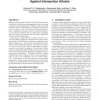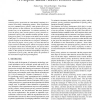151 search results - page 17 / 31 » Minimality Attack in Privacy Preserving Data Publishing |
PVLDB
2010
13 years 6 months ago
2010
Random perturbation is a promising technique for privacy preserving data mining. It retains an original sensitive value with a certain probability and replaces it with a random va...
CONEXT
2009
ACM
13 years 8 months ago
2009
ACM
Building on the popularity of online social networks (OSNs) such as Facebook, social content-sharing applications allow users to form communities around shared interests. Millions...
LOCA
2009
Springer
14 years 2 months ago
2009
Springer
Abstract. Location-based Services are emerging as popular applications in pervasive computing. Spatial k-anonymity is used in Locationbased Services to protect privacy, by hiding t...
CCR
2010
13 years 7 months ago
2010
In recent years, academic literature has analyzed many attacks on network trace anonymization techniques. These attacks usually correlate external information with anonymized data...
IEEEIAS
2007
IEEE
14 years 2 months ago
2007
IEEE
: Achieving privacy preservation in a data-sharing computing environment is becoming a challenging problem. Some organisations may have published privacy policies, which promise pr...


